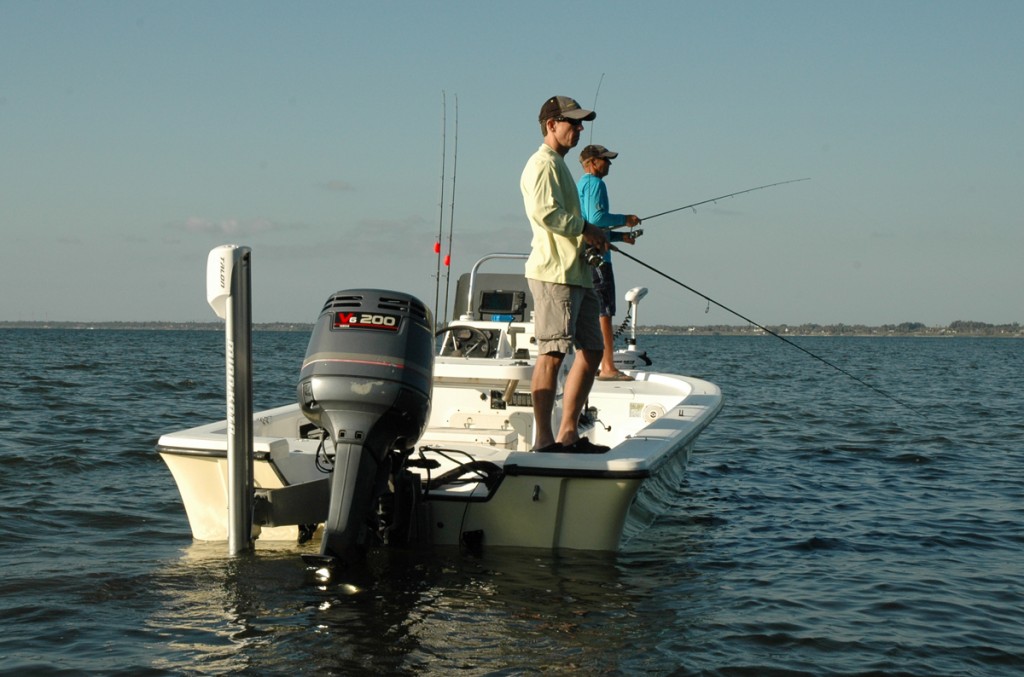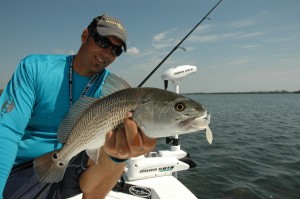September 04, 2014
By Jeff Weakley
Some days, silence is more important than mobility.
 A powered stake anchor at the transom will come in very handy in the event these anglers drift into a bunch of fish.
A powered stake anchor at the transom will come in very handy in the event these anglers drift into a bunch of fish.
It's the classic image of sight fishing the flats: A skiff with a man high atop an aft poling platform, using a long pole to urge the boat along in search of bonefish, tarpon or redfish. The outboard
engine is quiet, the sound of the pole merely a series of scratches on the marl bottom.
A modern impression would include an electric trolling motor, the effects of whose subtle whir is hard to pin down. Some days fish seem to ignore it, other days they flee, in skinny water anyway.
An interesting hybrid technique, useful in all manner of fishing boats, is the gentle drift-and-search, where you find a high spot on the boat and let your eyes roam the surrounding water, alert for subtle shadows, movement, flashes (once you recognize a redfish flash, you'll begin seeing them everywhere!).
In hard-pressured areas, especially, sometimes it makes good sense to just let the boat drift naturally.
Stopping is of course a big concern, for a couple of reasons.
One, if you happen to locate a foraging redfish, for instance, you'll want to make a quick, clean presentation with your bait or lure. That's tough to do if the boat is moving. Also, when you do find what you're looking for—be it a laid-up snook or a flats-cruising tarpon—odds are good you've found a key travel lane used by the fish. More might be along any moment.
Fish what you've found, then stay put for a few minutes more.
Powered stakeout devices, such as the electric Minn-Kota Talon and hydraulic Power-Pole, are especially handy for this approach.
Captain Ed Zyak, a Martin County light tackle guide, fishes out of a 20-foot bay boat that's far too heavy for traditional poling, but nevertheless sufficient to float in 12 or 14 inches of water. Like many anglers, he spends a good deal of time on the trolling motor, adjusting for casts at shorelines, docks, bridges and other features.
But on certain stretches of dense seagrass in the Indian River Lagoon, Zyak is apt to keep completely quiet and stand atop his console. In one hand, a spinning rod; around his neck, a lanyard for the Minn-Kota Talon. Pressing a key activates the Talon's spike, which drives into the bottom and holds the boat still.
Zyak watches for the brick red shapes of redfish to stand out among the millions of mullet that crowd these flats most of the year. With a 7- or 7 1/2-foot spinning rod and a soft-plastic bait rigged on a weighted hook, success is just a long cast away. The fish are unaware of what's inbound, no motor, no pushpole scrape, no alarm.
With some planning, you can really cover the water this way. After making a drift, power up (trolling motor or outboard), circle around to a new lane, and begin again. Picture a grid on the flat, with the spaces between each lane of drift separated by two long casts. Leave your engine tilted down some to help slow the boat; that way you can also turn the wheel to port or starboard, to crab across the drift, if desired. Or, if you have a trolling motor, use gentle pulses to adjust your drift as needed. FS
Other Options
 Captain Ed Zyak with a Fort Pierce redfish.
Captain Ed Zyak with a Fort Pierce redfish.
I've been around this technology for a few years now, and I can safely say that powered stake anchors are worth the investment, especially if you fish a few dozen days of the year.
Many skiff- and bayboat-owners pair up a trolling motor at the bow, a stake anchor at the stern, but for waters where long drifts across open grassflats are part of the drill, I could see buying the stake anchor before the trolling motor. It's just that useful.
Otherwise, some kind of manual staking device, such as a Cajun anchor or even a short pushpole, can make do. A downside to the manual stake, however, is that it's sometimes difficult putting on the brakes quickly: In strong current or a breeze, as you press the pole into the mud or sand, the boat is liable to continue moving some. Not so with the thin, vertical spike of a Talon or Power-Pole.
A small Danforth anchor is another solution; put a towel on the front deck, and lay the anchor there. When you wish to stop, ease the anchor over. Again, though, don't expect the kind of immediate reaction you get with the powered stake anchors. You boat will drift, and pivot, until it comes tight on the rode.
Boat drifting too fast? Try a collapsible sea anchor, or drift sock. They're affordable and easy to stow in a locker. For small-boat fishing applications, you can skip the expensive storm anchors, and just get the $50 model. For years, I spent many happy days drifting the flats in a 17-foot center console with nothing more than a drift sock and a 12-foot, two-piece fiberglass pushpole; when I found fish, I'd use the rope from the drift sock to make a quick hitch on the Y-end of the pushpole. Simple, sneaky, cheap and foolproof—but nowhere near as quick or convenient as the new powered stakes.
First Published Florida Sportsman July 2011

